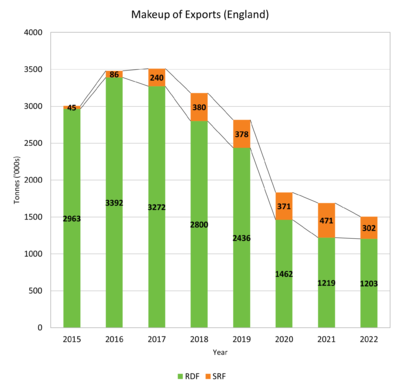Solid Recovered Fuel: Difference between revisions
m minor text changes |
m expanded text |
||
| Line 13: | Line 13: | ||
! Parameter !! [[RDF]] Example !! SRF Example | ! Parameter !! [[RDF]] Example !! SRF Example | ||
|- | |- | ||
| [[CV]] || 11 MJ/kg || 18 MJ/kg | | Net [[CV]] || 11 MJ/kg || 18 MJ/kg | ||
|- | |- | ||
| [[Moisture Content]] || 25% || 15% | | [[Moisture Content]] || 25% || 15% | ||
|- | |||
| Chlorine || <1% || <0.6% | |||
|- | |- | ||
| Particle Size || 300mm || 40mm | | Particle Size || 300mm || 40mm | ||
|} | |} | ||
Increasingly the market is considering further refinement of SRF which has been made into a pellet for ease of storage, haulage, and introduction into a [[Cement Kiln]], with some companies seeking to achieve [[End of Waste]] classification that would then enable the material to be used in other applications as a blended substitute for coal - an example of this is Subcoal <ref>[https://www.np-recycling.nl/en/alternative-fuels/subcoal.html N+P website]</ref>. | Increasingly the market is considering further refinement of SRF which has been made into a pellet for ease of storage, haulage, and introduction into a [[Cement Kiln]], with some companies seeking to achieve [[End of Waste]] classification that would then enable the material to be used in other applications as a blended substitute for coal - an example of this is Subcoal <ref>[https://www.np-recycling.nl/en/alternative-fuels/subcoal.html N+P website]</ref>. Chlorine is a particular issue due to its tendency to form Hydrochloric Acid in an energy recovery process, which then requires specific abatement technologies - with limited such arrangements in [[Cement Kilns]] this means that they generally have a lower tolerance for Chlorine closer to an SRF. | ||
==References== | ==References== | ||
<references /> | <references /> | ||
Revision as of 09:57, 20 April 2020
Solid Recovered Fuel (SRF) is distinct from RDF in that its quality as a fuel is far superior. It is typically used in processes that require a high quality, small particle size, high Calorific Value, low Moisture Content material – such as cement kilns and new-generation ATT plants.
Solid Recovered Fuels are covered by international technical specifications which set, amongst other parameters, the chemical and physical parameters of an SRF [1]
Whilst the data for the export of SRF from the UK is often reported within the overall Waste Derived Fuel/RDF statistics, there is increasing evidence of a proportional growth in SRF production and export in the context of a reduction in RDF export[2].

Typical differences in the key parameters of RDF and SRF mentioned above are broadly as follows:
| Parameter | RDF Example | SRF Example |
|---|---|---|
| Net CV | 11 MJ/kg | 18 MJ/kg |
| Moisture Content | 25% | 15% |
| Chlorine | <1% | <0.6% |
| Particle Size | 300mm | 40mm |
Increasingly the market is considering further refinement of SRF which has been made into a pellet for ease of storage, haulage, and introduction into a Cement Kiln, with some companies seeking to achieve End of Waste classification that would then enable the material to be used in other applications as a blended substitute for coal - an example of this is Subcoal [3]. Chlorine is a particular issue due to its tendency to form Hydrochloric Acid in an energy recovery process, which then requires specific abatement technologies - with limited such arrangements in Cement Kilns this means that they generally have a lower tolerance for Chlorine closer to an SRF.
References
- ↑ [1] ISO/TC 300 Solid Recovered Fuels
- ↑ CIWM Presidential Report 2018 – RDF Trading in a Modern World
- ↑ N+P website
